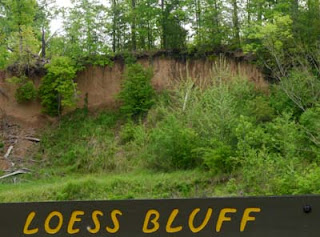After exploring the city of Natchez and spending two
nights at Natchez State Park, we were eager to start our adventure on the Natchez
Trace Parkway. Beginning
in Natchez, Mississippi and ending in Nashville, Tennessee, the Natchez Trace
Parkway took 67 years to construct but thousands of years to create the stories.
The National Park Service manages the Parkway
and the numerous wayside exhibits, interpretive signs, nature trails and
historic and cultural heritage sights along the road.
 |
| Along the Natchez Trace |
 |
| A one-way, 2.5 mile section of the Old Trace accessible to cars |
While the Parkway follows the original 'Old Trace' closely, it takes some liberties for a smoother ride. But there are places where cars can take sections of the original path. On one of those sections David and I were treated to the sight of a barred owl that flew ahead of us, landed on the Trace and then flew and perched in a tree above us. There are also sections of the Old Trace that you can hike, 65 miles of it have been designated a National Scenic Trail. In places the wagon wheel ruts and the mud holes where the wagons bogged down are still visible.
Soft, easily eroded soils called 'loess' make up several sections of the Old Trace.
These sections of the Trace 'sunk' over time with heavy use.
'Sunken Trace,' one of those deeply eroded sections of the original Trace
If we had stopped at every pull out, taken every trail and explored every town and city along the Natchez Trace, it might have taken a month or more. Which is approximately how long it took the “Kaintuck” boatmen, who floated their goods down the Mississippi River, to walk back home on the Old Trace after selling everything including the boat in New Orleans. As it was we spent 5 days along the Natchez Trace learning about our nation’s history and thoroughly enjoying the natural world of a place unspoiled by human blight.
One of the many waterfalls at Falls Hollow
Virginia Worm Rail Fence






No comments:
Post a Comment